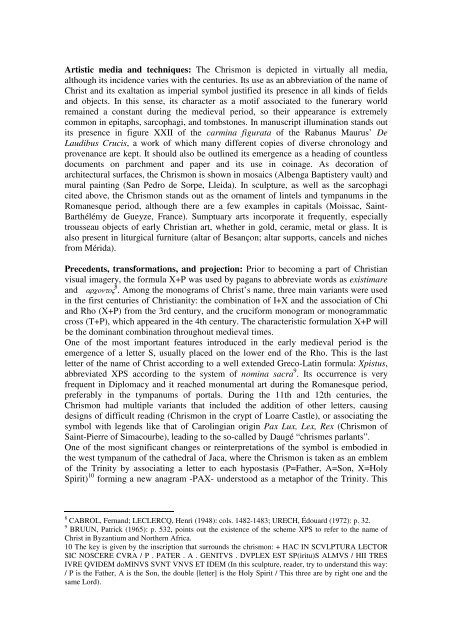Chrismon, Monogram, Late Antiquity, High Middle Ages. Sum
Chrismon, Monogram, Late Antiquity, High Middle Ages. Sum
Chrismon, Monogram, Late Antiquity, High Middle Ages. Sum
You also want an ePaper? Increase the reach of your titles
YUMPU automatically turns print PDFs into web optimized ePapers that Google loves.
Artistic media and techniques: The <strong>Chrismon</strong> is depicted in virtually all media,although its incidence varies with the centuries. Its use as an abbreviation of the name ofChrist and its exaltation as imperial symbol justified its presence in all kinds of fieldsand objects. In this sense, its character as a motif associated to the funerary worldremained a constant during the medieval period, so their appearance is extremelycommon in epitaphs, sarcophagi, and tombstones. In manuscript illumination stands outits presence in figure XXII of the carmina figurata of the Rabanus Maurus’ DeLaudibus Crucis, a work of which many different copies of diverse chronology andprovenance are kept. It should also be outlined its emergence as a heading of countlessdocuments on parchment and paper and its use in coinage. As decoration ofarchitectural surfaces, the <strong>Chrismon</strong> is shown in mosaics (Albenga Baptistery vault) andmural painting (San Pedro de Sorpe, Lleida). In sculpture, as well as the sarcophagicited above, the <strong>Chrismon</strong> stands out as the ornament of lintels and tympanums in theRomanesque period, although there are a few examples in capitals (Moissac, Saint-Barthélémy de Gueyze, France). <strong>Sum</strong>ptuary arts incorporate it frequently, especiallytrousseau objects of early Christian art, whether in gold, ceramic, metal or glass. It isalso present in liturgical furniture (altar of Besançon; altar supports, cancels and nichesfrom Mérida).Precedents, transformations, and projection: Prior to becoming a part of Christianvisual imagery, the formula X+P was used by pagans to abbreviate words as existimareand αρχοντος 8 . Among the monograms of Christ’s name, three main variants were usedin the first centuries of Christianity: the combination of I+X and the association of Chiand Rho (X+P) from the 3rd century, and the cruciform monogram or monogrammaticcross (T+P), which appeared in the 4th century. The characteristic formulation X+P willbe the dominant combination throughout medieval times.One of the most important features introduced in the early medieval period is theemergence of a letter S, usually placed on the lower end of the Rho. This is the lastletter of the name of Christ according to a well extended Greco-Latin formula: Xpistus,abbreviated XPS according to the system of nomina sacra 9 . Its occurrence is veryfrequent in Diplomacy and it reached monumental art during the Romanesque period,preferably in the tympanums of portals. During the 11th and 12th centuries, the<strong>Chrismon</strong> had multiple variants that included the addition of other letters, causingdesigns of difficult reading (<strong>Chrismon</strong> in the crypt of Loarre Castle), or associating thesymbol with legends like that of Carolingian origin Pax Lux, Lex, Rex (<strong>Chrismon</strong> ofSaint-Pierre of Simacourbe), leading to the so-called by Daugé “chrismes parlants”.One of the most significant changes or reinterpretations of the symbol is embodied inthe west tympanum of the cathedral of Jaca, where the <strong>Chrismon</strong> is taken as an emblemof the Trinity by associating a letter to each hypostasis (P=Father, A=Son, X=HolySpirit) 10 forming a new anagram -PAX- understood as a metaphor of the Trinity. This8 CABROL, Fernand; LECLERCQ, Henri (1948): cols. 1482-1483; URECH, Édouard (1972): p. 32.9 BRUUN, Patrick (1965): p. 532, points out the existence of the scheme XPS to refer to the name ofChrist in Byzantium and Northern Africa.10 The key is given by the inscription that surrounds the chrismon: + HAC IN SCVLPTURA LECTORSIC NOSCERE CVRA / P . PATER . A . GENITVS . DVPLEX EST SP(iritu)S ALMVS / HII TRESIVRE QVIDEM doMINVS SVNT VNVS ET IDEM (In this sculpture, reader, try to understand this way:/ P is the Father, A is the Son, the double [letter] is the Holy Spirit / This three are by right one and thesame Lord).
















